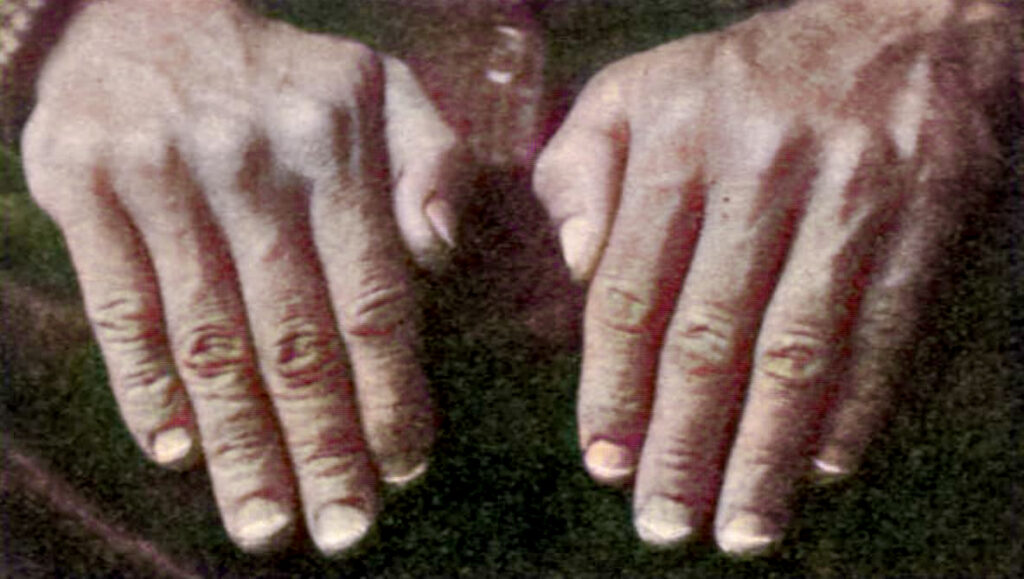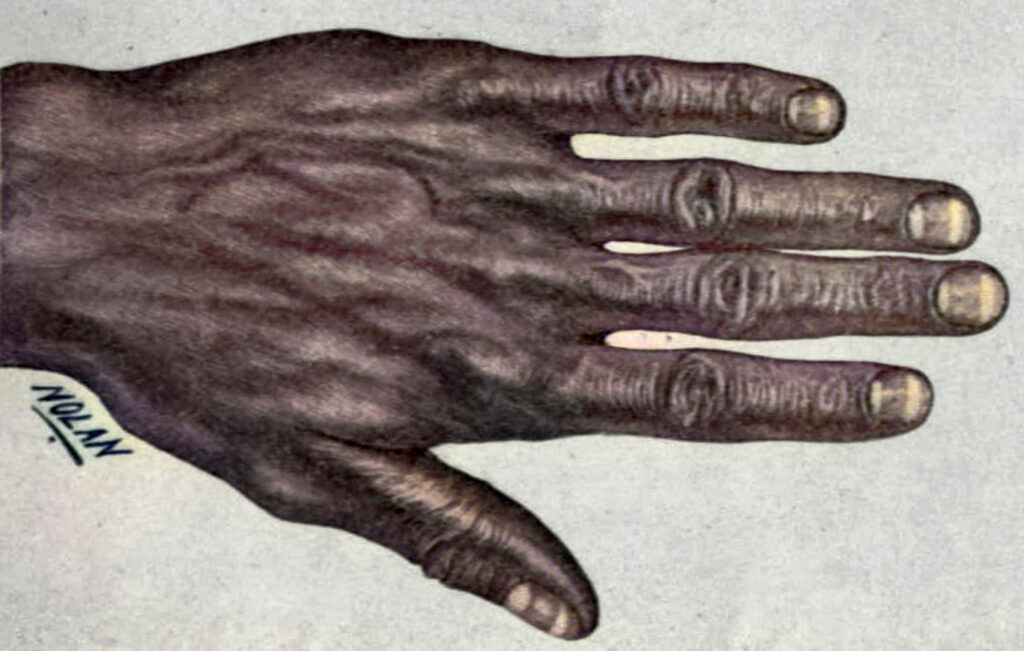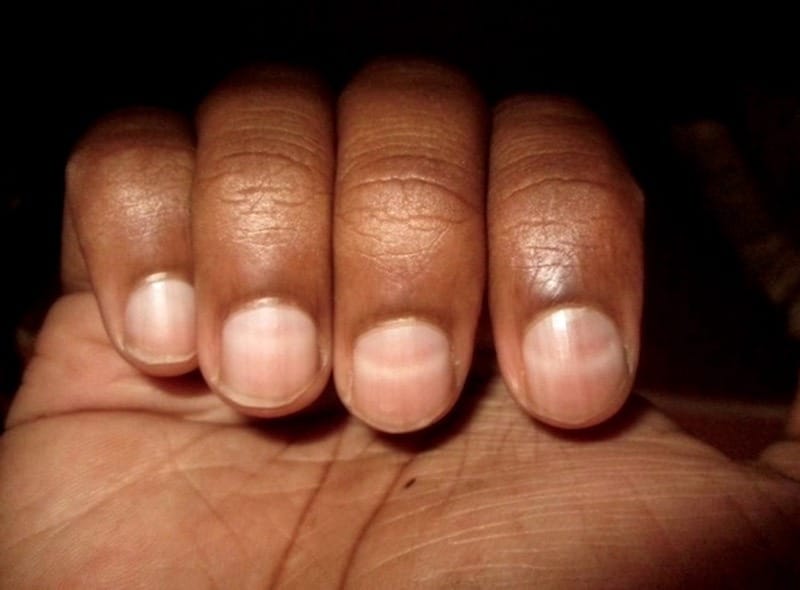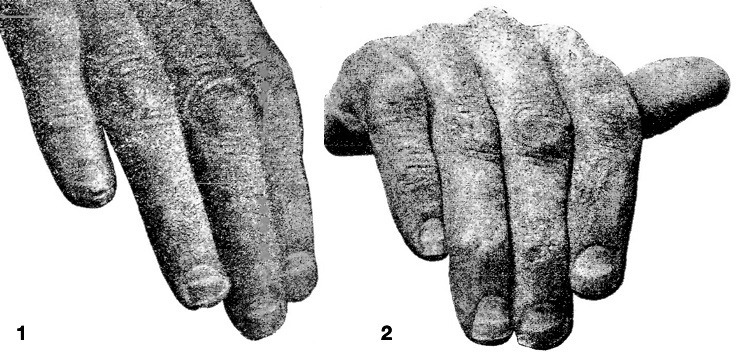Mees lines
Description
Mees lines are a true leukonychia with single or multiple white transverse lines running across the width of the finger and toe nails, parallel to the lunula; initially related to acute arsenic poisoning.
Mees Lines are a true leukonychia, a colour change of the nail with no palpable ridges; also called “leukonychia striata” or “Aldrich–Mees Lines.”
Mees lines:
- do not disappear with nail bed pressure
- usually have no nail surface irregularity
- can be seen, but not felt
- lines progress with the growth of the nail
Originally described as an indication of arsenic toxicity. The finding of leukonychia striata has subsequently been recorded in cases of heavy metal poisoning (arsenic, thallium and selenium); renal dysfunction; chemotherapy; systemic illness and high altitude mountaineering.
Patients with true leukonychias that involve the entire width of the nail of several fingers warrant a thorough physical examination, medication review, and query about possible toxic exposures.
Mees lines are differentiated from true leukonychia due to trauma as they:
- appear on several nails simultaneously
- involve the entire width of the nail
- have a contour similar to that of the lunula
History of Mees lines
1900 – Ernest Septimus Reynolds (1861-1926) wrote extensively regarding the effects of arsenic upon the beer drinking population of North England and the Midlands. In 1900-01 he published his findings and reviews in the BMJ, Lancet and Medico-Chirurgical Transactions concentrating on the signs and symptoms of polyneuropathy due to acute arsenic poisoning.
Nails: In many cases the nails are affected. After the patients have stopped taking the beer for some weeks the best appearances are seen, for then there is a transverse white ridge across the nail; proximal to this the nail is normal, but distal to it the nail is whiter, cracked, thin, and towards the tip almost papery and much flattened. In some cases there have been a series of parallel transverse ridges of the nails, also suggesting a series of week-end drinking bouts. These deformed nails of course break easily.
Reynolds 1901
1901 – Florence R. Sabin (1871-1953) described the signs and symptoms of a patient suffering from arsenical neuritis whom she saw in consultation with Dr William Osler:
The patient is a young woman who was brought to the hospital two months ago, November 23, 1900, after having taken about a dram of ‘Rough on Rats’…Her stomach was washed out repeatedly and large doses of the antidote given, together with epsom salts and castor oil. She was dismissed in five days feeling well, but noted that on walking up the steps of her home her feet were numb and the steps felt soft.
The numbness of the feet gradually increased and she became unable to walk. When she came to the hospital again she had double footdrop and wrist-drop, the muscles involved, however, were not entirely paralyzed. Her hands were so weak that she could not feed herself…On both hands there is a white line running transversely across each nail.
Sabin 1901
1904 – Charles John Aldrich (1861-1908) provided an early published description (1904) of three cases he treated in 1899, fifteen years before RA Mees 1919 description. Aldrich termed the phenomenon ‘Leuconychia striata arsenicalis transversus‘
Five years ago at the Cleveland City Hospital, while examining a woman suffering from a very severe arsenical neuritis, I was struck by the observance of a peculiar white transverse line occupying the middle of the outer third of the finger-nails of each hand. Taking into consideration the fact that the nails grow more rapidly following arsenical poisoning, I was able to estimate that these white lines corresponded to the time when, with suicidal intent, she had taken a teaspoonful of “Rough on Rats,” which is well known to contain a large quantity of arsenic.
Aldrich 1904: 702

The white streaks were about one-sixteenth of an inch in width, quite regular, with fairly sharp margins, and occupying an identical position on each nail. They were slightly larger on some nails than upon others and a little wider in the centre than near the margins; extended from side to side, forming a crescentic band, with the convexity directed to the free margins of the nail, and presenting a curve identical with that of the lunula. The markings were less plainly seen upon the toe-nails.
Aldrich 1904: 703

At that time I looked through the literature very carefully, but was unable to discover any reference whatever to such lines occurring in arsenical poisoning, and while I felt positive that in my case they were caused by the mineral, yet decided to wait for further confirmation of that opinion.
1919 – Rudolf Adriaan Mees (1873-1964) reviewed the cases of three patients with ‘polyneuritis arsenicosa’ (polyneuropathy due to acute arsenic intoxication) as a result of ingesting a large single dose of arsenic salts. He discusses two cases of attempted suicide and one of attempted murder.
Op de foto’s is het vershijnsel duidelijk waar te nemen. Over de nagels ziet men witte dwarsbanden loopen, die duidelijk niets met de lunula te maken hebben, aangezien onder den band, even goed als er boven, de nagel normaal rood van kleur is. Zooals begrijpelijk is, groeit dexe dwarsband met den nagel op en bij vergelijking van fig 1 met fig 2 ziet men een duidelijke verschuiving naar de peripherie van den nagelband op de laaste figuur…De breedte van den nagelband is ongeveer 1.5mm…Alle nagels van handen en vooten vertoonen denzelfeden dwarsband; hij is echter op de teenen veel minder duidelijk dan op de vingers
The phenomenon is clearly visible in the photos. White transverse bands are seen running over the nails, which clearly have nothing to do with the lunula, since under the band, as well as above, the nail is normally red in color. This transverse band grows with the nail and when comparing Fig. 1 with Fig. 2, a clear shift is seen towards the periphery of the nail band on the last figure…The width of the nail band is about 1.5mm…All nails of hands and feet show the same cross-band; however, it is much less clear on the toes than on the fingers
Mees suggested the use of the nail sign in diagnosing polyneuropathy due to acute arsenic intoxication
Waneer mocht blijken, dat bij polyneuritis arsenicose deze nagelband steeds aanwezig is van de tweede maand na de toediening van het vergift af en ongeveer twee maanden zeer duidelijk aanwezig blijft, dan kandit verschijnsel forensische beteekenis hebben. De band toch is nog aanwezig, als het arsenicum uit de urine is verdwenen. Een moeilijk te diagnosticeeren geval van polyneuritis zou dan door het aanwezig zijn van den nagelband asl polyneuritis aresenicos kunnen worden herkend.
If it turns out that in polyneuropathy due to acute arsenic intoxication this nail band is always present from the second month after the administration of the poison and remains very clearly present for about two months, this phenomenon can have forensic significance. The band is still present when the arsenic has disappeared from the urine. A case of polyneuropathy that is difficult to diagnose could then be recognized by the presence of the nail band as polyneuropathy due to acute arsenic intoxication
Mees had described the nail sign; identified the predisposing cause; hypothesised as to the pathological basis; and proposed the signs use in forensic analysis. identified. Now he set about reviewing the international literature for evidence of previous published documentation of the nail sign:
Wanneer ik nu naga, wat er in de literatuur van dit nagelverschijnsel te vinden is, dan kom ik tot de slotsom, dat op deze dwarsbanden dee aandacht nog niet werd gevestigd. De verhandelingen van REYNOLDS, waarin een uitgebreide epidemie van arsenicum-vergiftiging tengevolge van biergebruik wordt beschreven, bevatten niets daaroment. Het overzicht van deze verhandelingen (1901) in de Review of Neurology (1905) door denzelfden schrijver vermeldt alleen atrophische nagels zonder verdere aanduiding.
Now, when I examine what can be found in the literature of this nail phenomenon, I come to the conclusion that attention has not yet been drawn to these transverse bands. REYNOLDS treatises, which describe a comprehensive epidemic of arsenic poisoning from beer consumption, contain nothing. The review of these treatises (1901) in the Review of Neurology (1905) by the same author mentions only atrophic nails without further indication.
However, Reynolds did clearly define the nail changes of arsenical poisoning as a transverse white line in his 1901 papers presented in both the Lancet and Medico-Chirurgical Transactions.
Mees also refers to Reynolds publication in the Review of Neurology and Psychiatry (1905). In this paper Reynolds provided a comparative overview of arsenical neuritis and alcoholic neuritis to complement Buchanan’s paper ‘Some aspects of alcoholism‘ published within the same journal. True, there is no specific mention of nail changes, however this particular article was focused on the differences between alcohol and arsenic poisoning with respect to neuritis, neuropathy and skin pigmentation. No reference is made to the work of Sabin (1901) and Aldrich (1904)
Associated Persons
- Jacob Mendez Da Costa (1833 – 1900)
- Ernest Septimus Reynolds (1861 – 1926)
- Florence R. Sabin (1871 – 1953)
- William Osler (1849 – 1919)
- Charles J. Aldrich (1861 – 1908)
- Rudolf Adriaan Mees (1873-1964)
Alternative names
- leukonychia striata; leuconychia striata arsenicalis transversus
- Reynolds lines
- Aldrich – Mees lines;
- Reynolds-Sabin-Aldrich-Mees lines
Leukonychia striata in chronic disease
1877 – Jacob Mendez Da Costa (1833 – 1900) described transverse white bands the full width of the finger nail appearing after a relapse of typhoid fever. Coloured illustration of a hand the nails of which are traversed with several white bands, each corresponding to a relapse of the typhoid from which the patient had suffered. Systemic illness variant of Mees lines
1877 – Morris Longstreth published in the same journal edition as Da Costa his personal account of transverse white bands extending over the surface of the nails. These bands appeared after each exacerbation his own relapsing fever in 1869 with each band relating to a relapse of the fever.
Other eponymous nail signs
References
Original articles
- Da Costa JM. Relapses in Typhoid Fever. Transactions of the College of Physicians of Philadelphia. 1877; 3: 101-112
- Longstreth M. Changes in the nails in fever, and especially in relapsing fever. Transactions of the College of Physicians of Philadelphia. 1877; 3: 113-125
- Reynolds ES. An Account of the Epidemic Outbreak of Arsenical Poisoning occurring in Beer Drinkers in the North of England and the Midland Counties in 1900. Lancet. 1901; 157(4038): 166-170
- Reynolds ES. An Account of the Epidemic Outbreak of Arsenical Poisoning occurring in Beer Drinkers in the North of England and the Midland Counties in 1900. Medico-Chirurgical Transactions. 1901; 84: 409‐452
- Reynolds ES. A note on alcoholic and arsenical neuritis. Review of neurology and psychiatry, 1905; 3: 264-267
- Sabin FR. A case of arsenical neuritis. 1901; 12(124): 212
- Aldrich CJ. Leuconychia striata arsenicalis transversus, with report of three cases, American journal of the medical sciences. 1904; 127(4): 702–709
- Mees RA. Een Verschijnsel bij Polyneuritis Arsenicosa, Nederlands tijdschrift voor geneeskunde 1919; 63(1a): 391-396 [PDF]
Review articles
- Hutton JT, Christians BL. Sources, symptoms, and signs of arsenic poisoning. J Fam Pract. 1983;17(3):423‐426.
- Saddique A, Peterson CD. Thallium poisoning: a review. Vet Hum Toxicol. 1983;25(1):16‐22.
- Seavolt MB, Sarro RA, Levin K, Camisa C. Mees’ lines in a patient following acute arsenic intoxication. Int J Dermatol. 2002;41(7):399‐401.
- Chauhan S, D’Cruz S, Singh R, Sachdev A. Mees’ lines. Lancet. 2008;372(9647):1410.
- Richir MC, Langenhorst BLAM. Een vrouw met ‘jaarringen’ op haar nagels. Ned Tijdschr Geneeskd. 2011; 155: A3437
- Rohrig TP. Chapter 6: Anatomical Findings. In: Postmortem Toxicology, 2019: 59–77.
- Aujayeb A. Mees’ lines in high altitude mountaineering. BMJ Case Rep. 2019; 12(3): e229644
- Zhang G. Mees lines. Eponym A Day, Instagram
[cite]
eponymictionary
the names behind the name
Graduated from Southampton Medical School in 2017 with BMBS. Working in Sir Charles Gairdner Hospital Emergency Department in Perth, Australia.





